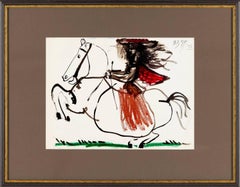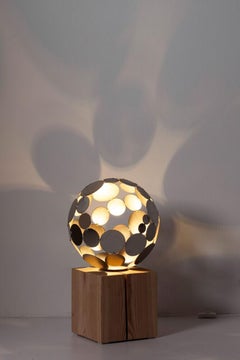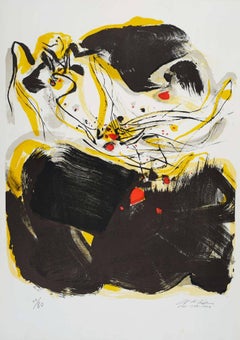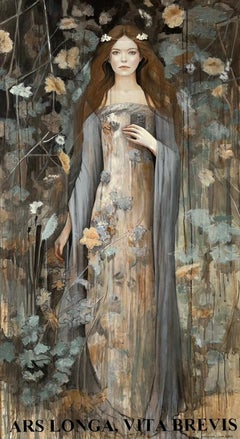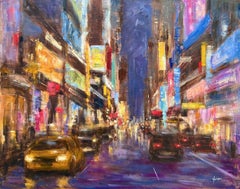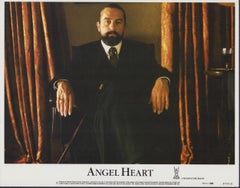Unframed More Art
1960s Modern More Prints
Lithograph
21st Century and Contemporary Art Deco Sculptures
Stainless Steel
Early 2000s Modern More Prints
Lithograph
2010s Contemporary Figurative Paintings
Canvas, Acrylic
Artist Comments
Artist Yangzi Xu depicts a lively nighttime scene of New York City. She fills the composition with recognizable aspects such as tower...
21st Century and Contemporary Abstract Impressionist Interior Paintings
Oil
1980s Modern Interior Prints
Color
1960s Modern More Prints
Lithograph
Late 19th Century Still-life Paintings
Oil, Canvas
Artist Comments
In this piece, artist Laura Browning explores the subtle shifts between light reflecting on top of the water's surface, and the ...
21st Century and Contemporary American Realist Landscape Paintings
Oil
Late 20th Century Abstract Geometric More Art
Tapestry, Wool
2010s Contemporary More Art
Oil, Wood Panel
21st Century and Contemporary Contemporary Abstract Sculptures
Paper
1950s Modern More Prints
Lithograph
2010s Realist Landscape Paintings
Oil, Other Medium
21st Century and Contemporary Minimalist Abstract Paintings
Canvas, Acrylic
1940s American Impressionist Landscape Paintings
Oil, Board
Artist Comments
The sky and clouds can be unpredictable, offering no certain forecast for the weather ahead. A gathering of dark clouds may hint at rain or a refreshing cooln...
21st Century and Contemporary Impressionist More Art
Acrylic
2010s Pop Art More Art
Resin, Vinyl
2010s More Art
Wood
21st Century and Contemporary Art Deco Sculptures
Steel
Mid-20th Century American Impressionist Landscape Paintings
Canvas, Oil
1980s Pop Art More Art
Lithograph, Offset
2010s Abstract Abstract Paintings
Paper, Mixed Media, Acrylic
2010s Contemporary More Art
Archival Paper
1960s Pop Art More Art
Paper, Offset
1980s Pop Art More Art
Offset
2010s Abstract Expressionist More Art
Porcelain, Screen, Cardboard, Mixed Media
2010s American Realist Landscape Paintings
Casein, Panel
Late 20th Century Rococo More Art
Tapestry
2010s Figurative Paintings
Canvas, Mixed Media, Oil
2010s More Art
Fabric
21st Century and Contemporary Photorealist Landscape Paintings
Oil, Board
2010s Contemporary Paintings
Paper, Pastel
Late 20th Century Medieval More Art
Tapestry
2010s Abstract Expressionist Abstract Paintings
Acrylic, Wood Panel
1990s Tribal More Art
Organic Material
2010s Pop Art More Art
Metal
2010s Neo-Expressionist More Art
Canvas, Acrylic
2010s Neo-Expressionist More Art
Canvas, Acrylic
Artist Comments
This painting is part of Suren Nersisyan's series of California landscapes focusing on the nature and stunning light around Los Angeles. He draws inspiration ...
21st Century and Contemporary Abstract Impressionist More Art
Oil
18th Century Landscape Paintings
Canvas, Oil
Artist Comments
Artist Yangzi Xu depicts a breathtaking evening scene at dusk on Wacker Drive, Chicago. "The lights of the city are on, creating a mesmerizing effervescence t...
21st Century and Contemporary Impressionist Interior Paintings
Oil
2010s More Art
Canvas, Oil
Artist Comments
This painting is part of Suren Nersisyan's series of California landscapes focusing on the nature and stunning light around Los Angeles. He draws inspiration from the residential streets, parks and gardens that dot the vast city. Of this piece, Suren says Just before dusk, the soft light from the sun and the beautiful colors of vintage buildings...
21st Century and Contemporary Abstract Impressionist Interior Paintings
Oil
2010s Abstract Abstract Paintings
Canvas, Oil
Early 2000s More Art
Stainless Steel
2010s Pop Art More Art
Resin, Vinyl
Artist Comments
Tall trees with lush green foliage create an archway over a narrow waterway. A small boat with a blue hull docks along the water, adding a focal point to the ...
21st Century and Contemporary Impressionist More Art
Oil
21st Century and Contemporary Abstract Abstract Paintings
Canvas, Acrylic
2010s Contemporary Figurative Paintings
Canvas, Acrylic
Artist Comments
Lush trees frame a serene pond, where the water reflects the vivid sky and its fluffy white clouds. Lily pads float gently on the surface, adding a touch of g...
21st Century and Contemporary Impressionist More Art
Oil
Artist Comments
Artist Jaime Ellsworth captures a clever brown dog skillfully balancing a red ball and a black bird on its head. With curious gazes, the critters turn to their right as if something has piqued their interest. The two-tone backdrop of ochre and moss green sets the stage for this endearing scene.
About the Artist
Jaime Ellsworth paints animals. Her career as a cowhand never got off the ground, so she stumbled into art never knowing it would complement her passion for animals so completely. Most subjects are her own, but lately she has expanded out of her corral to include bears and beasts not commonly seen on San Juan Island, in the Pacific Northwest, where she's lived for the last 30 years. She suspects it will be years before she runs out of inspiration or has jeans that aren’t covered with paw prints or paint.
Words that describe this painting: dog, bird, ball, whimsical, happy, playful, animals, acrylicpaint, portrait, profile, primitive, animals, primitive, acrylic painting, brown
Dog Ball...
21st Century and Contemporary Outsider Art Animal Paintings
Acrylic
Artist Comments
The serene waters, colorful trees, and majestic mountains contribute to the enchanting ambiance of Lake Tahoe. The vibrant hues and rich texture capture the s...
21st Century and Contemporary Impressionist More Art
Oil
15th Century and Earlier More Art
Terracotta
2010s Contemporary Figurative Sculptures
Stone, Granite, Bronze
1960s Modern Abstract Sculptures
Gold, Bronze
2010s Contemporary More Art
Canvas, Oil
2010s Pop Art More Art
Canvas, Color
1980s Pop Art More Art
Offset
